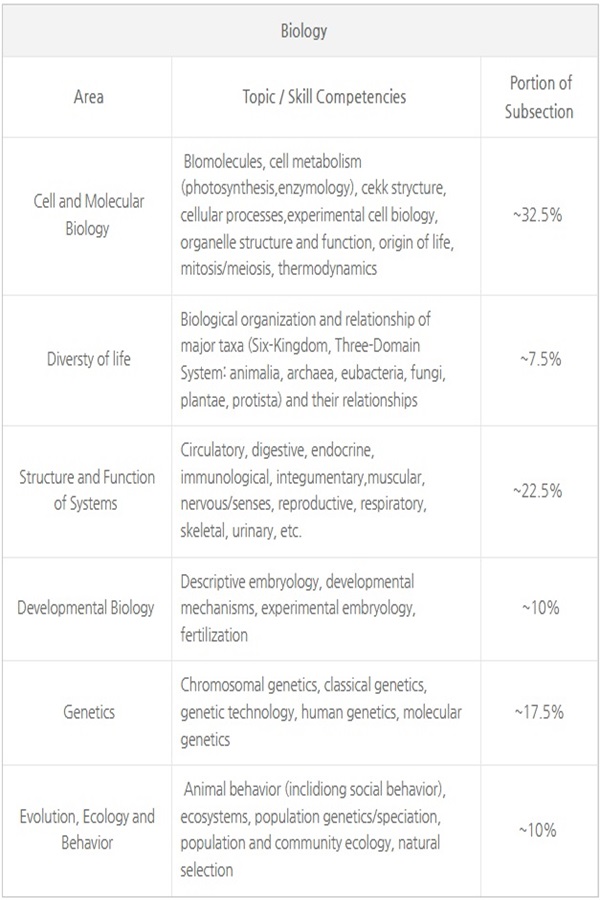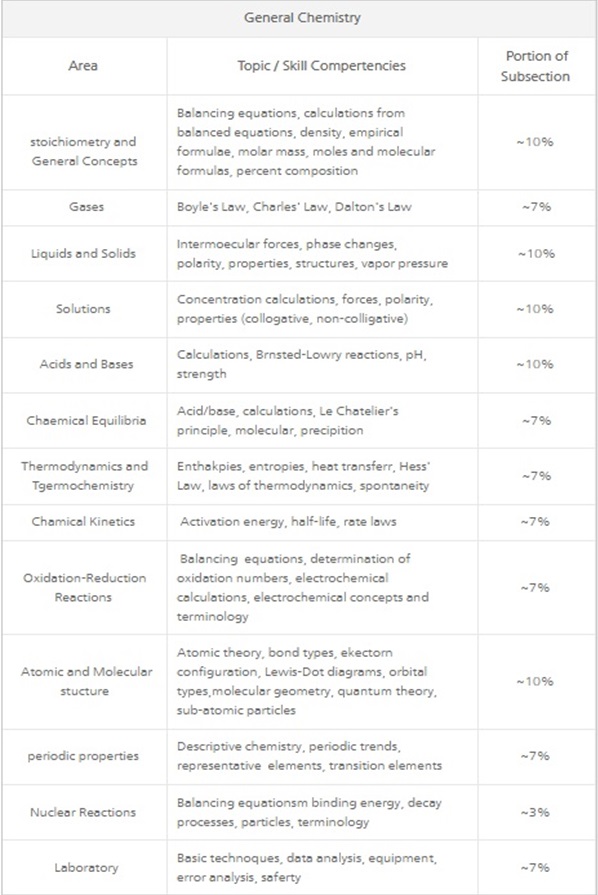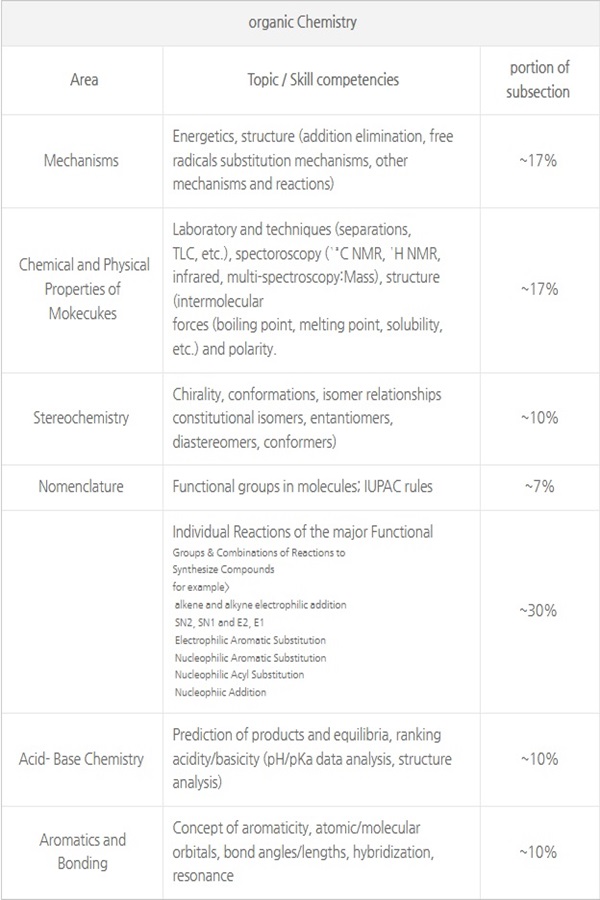MCAT/DAT
자연과학 전문컨설팅 그룹 WICIPE
MCAT
1. 시험 개요
미국, 캐나다, 호주의 Medical School(MD, 의학전문대학원) 지원을 위한 시험
미국의 MD 130여 곳 중 30~40 곳 정도가 유학생을 선발하고 있음
-
미국과 캐나다의 의대 진학을 위해서는 GPA 관리와 함께 MCAT 고득점이 필요합니다. 시험 준비를 위해 모의고사나 유사 기출 문제를 풀어본 학생들이 느끼는 시험의 난이도는 상당히 높고 이에 따라 느껴지는 당혹감도 큽니다.
MCAT의 문제는 학부 과정의 일반적인 시험 문제와 다르기 때문에 철저한 준비 없이 시험을 치르면 몇 번 되지 않는 시험 기회만 허비하게 됩니다.
-
MCAT의 문제들은 문장 독해 능력과 더불어 전문적인 과학적 지식을 요구하는 문제들입니다. 해외에서 유학하는 학생이라면 영어 독해 능력은 어느 정도 갖추어져 있기 때문에 역시 관건은 과학 공부입니다.
- 컴퓨터 기반의 표준화된 시험(CBT)으로 모든 문제는 선택형이고, 총 시험시간은 7시간 30분입니다.
- 매년 3회의 시험을 볼 수 있으며 점수의 유효기한은 2년 → MCPT 시험은 1년에 약 20번 정도 실시되며 보통 1월, 4~9월에 시험이 있습니다. 가급적 3번 내에 목표 점수를 받을 수 있도록 준비해야 합니다.
- 한국에는 시험 장소가 없으며 일본, 대만, 싱가포르에서 응시 가능합니다.
2. 시험 구성
총 4개의 파트로 구성
Ⅰ. Biological and Biochemical Foundations of Living Systems (59문항 95분)
Ⅱ. Chemical and Physical Foundations of Biological Systens (59문항 95분)
Ⅲ. Psychological, Social, and Biological Foundations of Behavior (59문항 95분)
Ⅳ. Critical Analysis and Reasoning Skills (53문항 90분)
Ⅰ. Biological and Biochemical Foundations of Living Systems
- 기초생물학 + 생화학
- 과학 지식, 과학적 조사, 논리, 리서치, 통계학적 기술과 관련된 문제
Ⅱ. Chemical and Physical Foundations of Biological Systens
- 자연과학
- 조직과 기관의 작용, 육체적, 생화학적 기능의 이해와 관련된 문제
Ⅲ. Psychological, Social, and Biological Foundations of Behavior
- 심리학, 사회학, 생물학, 연구방법과 통계학
- 건강 관련 행동과 사회 문화적 요인과 관련된 문제
Ⅳ. Critical Analysis and Reasoning Skills
- 사회과학과 인류학 관련 정보를 비판적으로 분석하는 문제
- 윤리, 철학, 문화, 건강 관련 내용으로 구성된 지문 분석
3. 시험 유형
- 자연과학 항목 ( Ⅰ과 Ⅱ) 별 59개의 문제 중 15개의 Indpendent Question (memory based questions – 지식), 나머지 문제는 passage-based question (memory based questions – 이해 및 적용)으로 출제됩니다.
- 자연과학 항목별로 8-10개의 passage (대부분 실제 논문에서 발췌 및 요약한 제시문)가 제시되고 passage 마다 4-6개의 set question이 출제됨 → passage를 이해, 분석, 추론할 수 있는 능력이 요구됩니다.
- 일반생물학 45문항, 생화학 30문항, 물리학 15문항, 일반화학 20문항, 유기화학 11문항 → 각 과목의 내용이 개별적으로 출제되는 것이 아니라 여러 과목이 유기적으로 연계된 문제가 출제
4. 성적 처리
- 각 항목 당 만점 132점, 최하점 118점으로 총 528점 만점입니다.
- 점수 분포는 500점이 상위 50% → 의대마다 차이는 있으나 510점은 되어야 합격 가능성이 높습니다.
- MCAT의 비중이 가장 크고 학점, 봉사활동, Personal Statement(일종의 자기소개서), 추천서도 중요합니다.
Etc..
최근 미국 MD 탑 10
Harvard University. Johns Hopkins University, Stanford University, Columbia University, Northwestern University, University of chicago, University of pennsylvania, Vandervilt University, New York University, Washington University
시험 준비시기
- GAP year 없이 진학하는 경우에는 3학년 겨울 방학부터 준비
- GAP year를 둔다면 4학년 2학기 또는 졸업 후 여유 있게 준비하는 것을 권장합니다.
MCAT 자연과학 시험문제 예시
Ⅰ. Biological and Biochemical Foundations pf Living Systems
(passage)
The myocellular transmembrance Na+ gradient is important for proper cellular function. During septic shock, disruption of Na+ homeostasis often occurs and leads to decreased membrane potential and increased intracellular Na+. It has been found that failure of cellular energy metabolism is a common symptom in septic patients who do not respond to therapeutics. Because normal intracellular levels of Na+ are maintained by the Na+K+ ATPase, it is important to inderstand how metabolic energy production is linked to cation transport.
Researchers are interested inwhether the energy used for iontransport is derived from glycolysis or oxidative phosphorylation. This information would provide a vetter understanding of myocellular damage that occurs during critical illness. Experiments wereconducted to evaluate the effects of qlyclytic inhibition on cellular Na+ and K+ concentrations and lactate production in rat skeletal myocytes.
Rat skeletal muscle fibers were extracted and incubated in normal media (Control), glucose-free media (G(-)),and qlucose-free media wuth various concentrations of the glycolytic inhibitor iodoacetate (IAA). IAA directly prevents thr formation of 1,3-bisphosphoglycerate. After one hour in the media, the muscle tissues were assayed for intracellular Na+ snd K+ content and lactate production. cellular viability was determined by measuring the amount of lactate dehydroqenase (LDH) released, as LDH release is an indicater of cell death.
The results ate displayed in Figure 1.
Figure1 “Effects of glycolytic inhibition on intracellular Na+ and k+ content and lactate production with cellular viability measured by LDH refease. (Note: The *indicates p < 0.05 versus control.)
DAT
1. 시험 개요
- 전체 5지 선다형 280문제
- Computer-based test (CBT)로 1년 중 상시 응시 가능합니다. 다만, 응시하면 다음 시험까지 3달 정도 기회가 제한됩니다.)
- 일반적으로 3학년 말에 응시(8월이면 늦은 편), 점수의 유효기간은 2년
- 계산기를 사용할 수 없습니다.
2. 시험 구성
자연과학 100문제, 90분 – 문항 당 54초 권장
계산 문제가 많은 일반화학에 더 많은 시간을 할당하는 것이 일반적
일반생물학 (General Biology) 40문제
일반화학(general chemistry) 30문제
유기화학(organic chemistry) 30문제
perceptual Ablility Test (PAT) 90문제, 공간 지각 능력 테스트
Reading Comprehension (RC) 50문제, 치과 쪽이나 기본적 과학 지식들에 대한 읽기 능력과 비평 능력 테스트
Qualitative Reasoning (QR) 40문제, 수학 (trigonometry, algebra)



3. 성적 처리
성적 처리
- 섹션별로 환산 점수 산출 – 섹션별 환산 점수 30점 만점, 일반적으로 17점이 평균
- AA 와 TS는 따로 점수 산출
Academic Average (AA) = NS + RC + QR
Total Sciene (TS) = 생물 + 화학 + 유기
→ 21점 이상 매우 우수, 20점 우수, 19점 평균, 18점 지원가능 최저, 17점 부족
→ 평균 합격 AA는 18~20 (Havard 22-23), 영주권자가 아닌 유학생은 23 이상이 필요
- GAP + DAT + 인터뷰
→ GAP + DAT로 주로 선발
→ GAP가 충분히 높으면 ( 3.3~3.8 정도 필요, 입학생 평균 학점 3.5) DAT점수로 심사 즉, DAT 점수가 매우 중요
→ 치전원 마다 DAT 영역별 반영 비율이 다름
한국 학생들이 많이 진학하는
미국 치대 컴바인드 프로그램
- NYU BA DDS 프로그램
- Adelphi Unversity
- UOP (University of the Pacific)
- Case Western Reserve University
- College of Wooster
- UDM (University of Detroit Mercy)
미국 치대 목록
- University of Michigan School of Dentistry, UCLA School of Dentistry, UCSF School of Dentistry, UNC School of Dentistry, NYU College of Dentistry
- University of College of Dentistry, University of Minnesota School of Dentistry, Hetman Ostrow School of Dentistry of USC, University of Connetucut School of Dental Medicine
- University of Pennsylvania School of Dental Medicine, University of Pittsburgh School of Dental Medicine, University of Washington-Health Sciences School of Dentistry, Stony Brook University School of Dental Medicine
- University of Marrland Baltimore College of Dental Surgery, University of Illinois College of Dentistry, Harvard University of School of Dental Medicine, University of Louisville School of Dental Medicine
- Columbia University College of Dentall Medicine, University of Iowa College of Dentistry, Tufts University School of Dental Medicine

